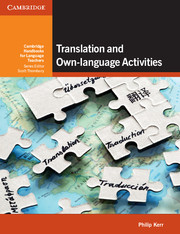Book contents
2 - A seminar for teacher development courses (in-service)
Published online by Cambridge University Press: 15 November 2023
Summary
Note
You could use Activity 3, Classroom observation task, in conjunction with this task.
Procedure
1 Put participants into groups. Write the questions below on the board and ask participants to discuss them. Allow approximately ten minutes.
• How often, and for what reasons, do you use the students’ own language in the classroom?
• Do you think your approach is similar or different to the majority of your colleagues?
• In terms of using the students’ own language, how similar or different is your approach to the teachers who taught you English?
Conduct feedback with the whole group. You will probably need about another ten minutes for this.
Feedback notes
Research indicates that the amount of time that teachers spend using the students’ own language varies enormously (from zero to as much as 90%!), although a probable average is about 20% (Levine, 2012).
Research also suggests that many teachers significantly underestimate the amount of time they spend using their students’ own language (Copland & Neokleous, 2011, p. 271). This is probably because they feel guilty about using the students’ language.
The reasons for using the students’ own language include: explaining language, administrative matters, managing interpersonal relations (including discipline and humour) There is enormous variation in the amount of time that teachers spend using the students’ language for these different functions.
2 Distribute the handout. Ask participants to read the text and then discuss their response with a partner.
3 Ask the group the following question: why do you think that many teachers and institutions believe that English-only is the best policy, despite the fact that the research suggests the opposite?
4 Display the photocopied activities and techniques on walls or desks around the room. Tell trainees to stand up and move around the room reading as many of these practical ideas as possible. Set a time limit of ten minutes.
5 Organise trainees into groups of four or five. Tell them to share the practical ideas they have discovered and to answer the following questions:
1 Which activities did you like most and least?
2 What problems might you have with these activities in a classroom?
6 Close the session with a whole-group opportunity for further discussion and questions.
- Type
- Chapter
- Information
- Translation and Own-language Activities , pp. 151 - 153Publisher: Cambridge University PressPrint publication year: 2014

